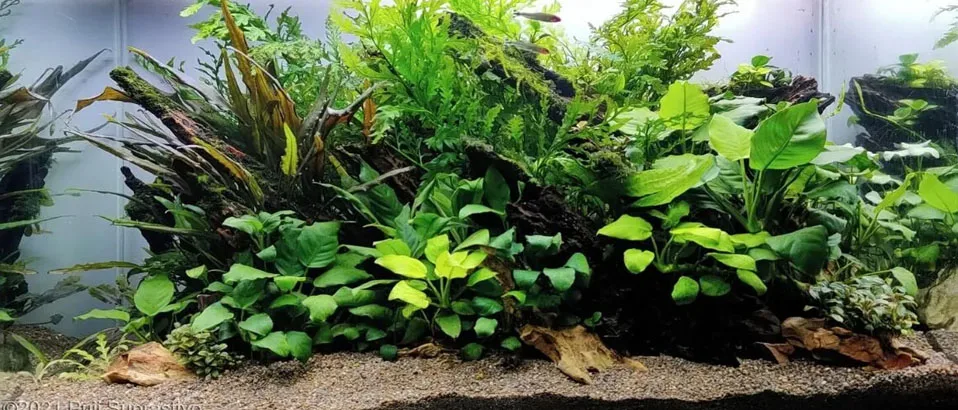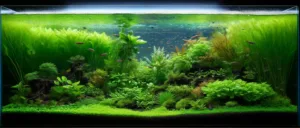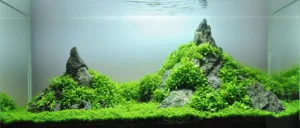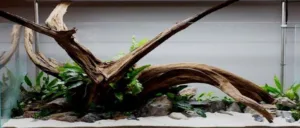Anubias is a genus of aquatic and semi-aquatic type of plants belonging to the Araceae family. Valued for its resilience and captivating appearance, Anubias plant is an indispensable part of the aquarium hobby. Its broad, dark green leaves make it an excellent choice for both beginners and seasoned aquarists.
Origins and Natural Habitat
Anubias plants originate from the tropical regions of West Africa. They are commonly found along riverbanks and streams, thriving in both submerged and emersed conditions. This adaptability to varied environments has contributed to their popularity in aquascaping.
Compatibility with Aquatic Life
| Category | Details |
|---|---|
| Suitable Tank Mates | Most community fish, shrimp, snails |
| Avoid | Plant-eating fish like cichlids, goldfish |
| Benefits to Fish | Provides hiding spots, reduces stress, offers foraging areas |
| Benefits to Invertebrates | Provides surfaces for algae and biofilm growth, natural food source for shrimp, snails |
| Plant Compatibility | Pairs well with Java Fern, Cryptocoryne, other low-light plants |
| Tank Types | Suitable for freshwater tanks, paludariums, ripariums |
Anubias Plant Types
Anubias Barteri
Anubias Barteri is one of the most popular and widely available types of anubias plant. It features large, robust leaves and can grow up to 16 inches in height. Its resilience to different water conditions makes it a favorite among aquarists.
Anubias Nana
Known for its compact size, Anubias Nana is ideal for smaller aquariums. It grows to about 4 inches tall and is often used to create lush foregrounds or as an accent on driftwood and rocks.
Anubias Congensis
Anubias Congensis is distinguished by its elongated, lance-shaped leaves. It can grow up to 12 inches tall and adds a unique texture to aquascapes. This variety is particularly suited for midground planting.
Anubias Afzelii
With its long, slender leaves, Anubias Afzelii provides a striking visual contrast in aquariums. It can reach heights of up to 20 inches, making it suitable for background placement in larger tanks.
Anubias Gigantea
As the name suggests, Anubias Gigantea is a large variety, capable of growing over 24 inches tall. Its impressive size makes it a focal point in spacious aquariums and paludariums.
Anubias Plant Care and Maintenance
Pruning and Trimming: Regular pruning helps maintain the shape and health of Anubias plants. Trim dead or yellowing leaves close to the rhizome to encourage new growth. Avoid cutting the rhizome itself.
Preventing Algae Growth: Algae can be a common issue with Anubias due to their slow growth rate. Reduce the risk by providing adequate water circulation, maintaining proper lighting, and using algae-eating species like Amano shrimp.
Nutrient Requirements: While Anubias fish tank plants are not heavy feeders, they benefit from occasional fertilization. Use liquid fertilizers or root tabs to provide essential nutrients, especially if they show signs of nutrient deficiency.
Common Problems and Solutions
Yellowing Leaves: Yellowing leaves can indicate nutrient deficiencies or unsuitable water conditions. Check your water parameters and provide appropriate fertilization to address the issue.
Rhizome Rot: Rhizome rot occurs when the rhizome is buried in the substrate. Ensure that it remains above the substrate and receives adequate water flow to prevent this problem.
Pests and Diseases: Anubias plants are generally resistant to pests and diseases. However, they can occasionally suffer from snail infestations or fungal infections. Treat affected plants with appropriate remedies and maintain good tank hygiene.
Planting Anubias in Your Aquarium
Choosing the Right Location: When planting Anubias, consider its growth habit and size. Place larger varieties of anubias in the background and smaller ones in the foreground or midground. Ensure they have enough space to spread out without overcrowding.
Planting Techniques: Anubias plants should be attached to hardscape elements like rocks or driftwood. Use fishing line or plant-safe glue to secure the rhizome. Over time, the roots will naturally attach themselves.
Anchoring Methods: If you prefer not to use fishing line or glue, you can wedge the rhizome between rocks or in crevices. This method allows the plant to establish itself without risk of damage.
Propagation of Anubias
Rhizome Division: The most common method of propagating Anubias aquarium plants is rhizome division. Simply cut the rhizome into sections, ensuring each piece has a few leaves and roots. Replant the sections in your aquarium.
Adventitious Shoots: Anubias can also propagate through adventitious shoots that sprout from the rhizome. These shoots can be separated and planted once they develop roots and a few leaves.
Seed Germination: Although less common, Anubias aquarium plants can be grown from seeds. This method requires patience and careful attention to water quality and lighting conditions. It is typically done by experienced aquarists.
Anubias Plant Flower
Appearance: The flowers of Anubias are small, white, and bloom on a spadix surrounded by a spathe, similar to those of other plants in the Araceae family. While not particularly showy, they add a unique touch to the plant’s overall appearance.
Flowering Conditions: Anubias plants can flower both underwater and above water in emersed conditions. Emersed growth, where the plant’s leaves are above water, often encourages more frequent flowering.
Pollination: In nature, Anubias flowers are pollinated by insects. In an aquarium setting, pollination is less common, but the flowers can still bloom without it. If you wish to encourage pollination, providing emersed growth conditions might help.
Maintenance During Flowering: When Anubias plants flower, they generally do not require any special maintenance. Simply continue with regular care routines, ensuring adequate lighting and nutrient supply. The flowers can last several weeks and add an interesting feature to the aquarium.
Propagation from Flowers: While Anubias can produce seeds from flowers, this method of propagation is rare and often challenging in home aquariums. Most aquarists rely on rhizome division or adventitious shoots for propagating Anubias plants.
Ideal Conditions for Growing Anubias
Water Parameters: Anubias plant thrives in a wide range of water parameters. It prefers a pH between 6.0 and 7.5 and temperatures ranging from 72 to 82°F. It’s adaptability to different water conditions makes it easy to care for.
Lighting Requirements: Anubias plant can grow under low to moderate lighting. High light can cause algae to grow on it’s leaves, so it’s best to provide filtered or diffused light. This makes anubias ideal for low-tech, low-light aquariums.
Substrate Preferences: While Anubias can grow in various substrates, they do not need to be planted in soil. Their rhizomes should be kept above the substrate to prevent rot. It can be anchored to rocks, driftwood, or other decorations.
Anubias Plant on Driftwood
Attaching Anubias to driftwood creates a natural and visually striking centerpiece in the aquarium. This method offers several advantages, such as maximizing space efficiency by utilizing vertical areas and enhancing the overall aesthetic appeal of the tank. Secure the rhizome using clear fishing line, plant-safe glue, or by wedging it into natural crevices in the driftwood. Proper placement is crucial – ensure good water circulation and low to moderate lighting to prevent algae growth on the leaves. This combination not only stabilizes the plant but also mimics natural aquatic environments, providing hiding spots and foraging areas for fish and invertebrates, contributing to a balanced and visually appealing aquascape.
Benefits of Anubias in Aquariums
- Enhances aesthetic appeal with broad, glossy leaves.
- Provides shelter and hiding spots for fish and invertebrates.
- Improves water quality by absorbing nitrates and other waste products.
- Stabilizes the substrate, preventing erosion.
- Adaptable to various water conditions, making it easy to care for.
- Compatible with a wide range of fish and invertebrates.
- Low light requirements, suitable for low-tech aquariums.
- Resistant to pests and diseases.
- Long-lasting and durable plant choice.
- Contributes to a balanced and healthy aquarium ecosystem.
Conclusion
Anubias plants are an exceptional choice for any aquarium enthusiast. Their resilience, aesthetic appeal, and compatibility with a wide range of aquatic life make them indispensable in the aquascaping world. Whether you are a beginner looking for an easy-to-care-for plant or an experienced aquarist seeking to add depth and texture to your underwater landscape, Anubias offers a versatile and rewarding option. By understanding their needs and proper care techniques, you can enjoy the benefits of these beautiful plants and create a thriving, visually stunning aquarium environment.




